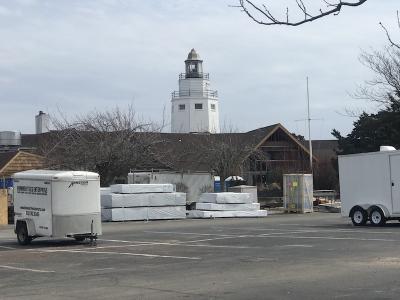Gurney’s Plans to ‘Greenify’ Former Yacht Club Complex

The owners of Gurney’s Montauk Resort and Seawater Spa on Old Montauk Highway, who are developing the former Montauk Yacht Club into Gurney’s Star Island Resort and Marina, presented two site plans to the East Hampton Town Planning Board on March 27.
George Filopoulos and Lloyd Goldman, the presidents, respectively, of Metrovest Equities and BLDG Management, the firms that own Gurney’s, bought the Montauk Yacht Club last May and announced a $13 million property-wide upgrade.
The yacht club complex occupies a four-plus-acre parcel on Lake Montauk that contains 84 guestrooms, a restaurant, four boutiques, indoor and outdoor pools, a garage with staff rooms, and approximately 95 parking spaces, according to a memo from JoAnne Pahwul, a town planner. An adjacent parcel contains a dock house with, among other amenities, two bathrooms, a sauna, storage for pool equipment, and a dockmaster’s office. Docks and finger piers with approximately 60 boat slips and bulkheads, a walkway, and a ship’s store, are also on the parcel.
Karen Hoeg, a lawyer representing Gurney’s Star Island Resort, said the resort’s development, to take place over several years, would result in a more environmentally-friendly facility. “The bigger project is to ‘greenify’ this resort area,” she said.
In one of the two applications presented to the board, the owners are proposing to demolish the dock house and construct, near the outdoor pool, a more than 200-square-foot building to contain two bathrooms and storage space for pool equipment. The site would be 11 feet from Lake Montauk, where a 150-foot setback is required, and would therefore require a wetlands setback variance and a natural resources permit from the East Hampton Town Zoning Board of Appeals.
“I’m happy they’re demolishing the dock building that’s right on the water,” said Louis Cortese, a board member. He and Kathy Cunningham, the vice chairwoman, however, took issue with bathrooms so close to the water, given that the property uses a conventional septic system. “It’s great that you’re moving out of the lake, but you’re not out of the impact zone,” Ms. Cunningham said. “It’s in the interest of your green enterprise to put in a low-nitrogen system.”
However, Ms. Hoeg said the Suffolk County Department of Health Services had informed her that approval to relocate the bathrooms was not necessary.
The second application, which the board deemed minor and therefore would not require a public hearing, calls for redesigning the entryway to the resort. An existing porte cochere has been demolished, and the owners want to build a 241-square-foot addition that would serve as an entrance, allow for the existing restaurant bathrooms to be handicapped accessible, and create space for a janitor’s closet.
Another 95-foot addition is proposed for an expanded reception area and office space, as well as a fire alarm control center. A pergola is proposed for a walkway, and electrical transformers would be moved to another part of the property that contains similar equipment.
In a separate application, Verizon Wireless sought site plan approval for a new personal wireless facility at the Gurney’s Resort complex on Old Montauk Highway. The six-foot-high facility would be on top of an existing dormitory. The enclosed structure would contain six antennas, nine remote radio heads, three GPS navigation units, and associated equipment and cabling. It would be 36 feet above ground level, where the maximum allowable under zoning is 25 feet. Although the structure would be well within the town code’s maximum 10-foot height limit for a wireless facility, John Jilnicki, the planning board’s lawyer, said a variance from the Z.B.A. might still be necessary.
Current cellphone reception at Gurney’s is “spotty at best,” said India DeCarmine, a lawyer representing Verizon. The wireless facility would improve coverage on the beach, within the resort’s lower-level conference rooms, and along more than a mile stretch of Old Montauk Highway, she said.
Ms. DeCarmine noted the owners of Gurney’s had written a letter of support, in which they said the resort “desperately needs” improved cell coverage. Ms. Carmine also submitted documentation that the facility would meet Federal Communications Commission standards.
The enclosure would be designed to blend with the color and architecture of the resort, said Ms. DeCarmine, who brought a panel of cedar-shingle-style screening to the meeting. A visual analysis and renderings of how the enclosure would look from 11 vantage points (including the beach and highway) also was submitted and displayed at the meeting.
“As far as the aesthetics go, I look at [Gurney’s] as a hodgepodge of buildings, and I think this little box on top of that building is going to go totally unnoticed,” Mr. Cortese said. His colleagues agreed, as did the members of the town’s architectural review board, which approved the structure on March 28.
